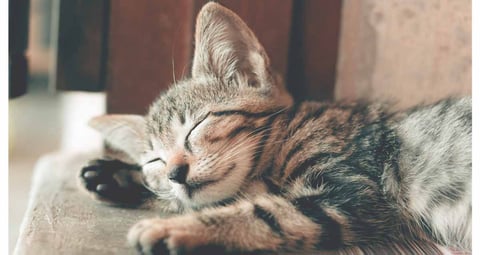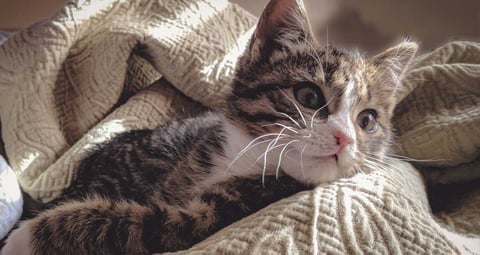Adopting a kitten can be an incredibly rewarding experience, but it comes with responsibilities. When you bring a kitten into your home, you are responsible for its health, wellbeing and happiness. So, what do you need to know to make the transition as easy as possible for you and your new kitten?
In this article, we look at the pros and cons of adopting a kitten, some general tips for care, and what you need to know about feeding and nutrition.
Should I buy or adopt a kitten?
One of the first things to consider is whether you want to buy or adopt a kitten. There is no right or wrong answer to this question, it’s simply a matter of what will best suit your situation.
Adopting a kitten can be a highly rewarding experience. You are essentially rescuing a kitten and giving it a new home. With adoption also comes choice, as you have a wide range of kittens and cats to choose from, of all ages and breeds. You may have trouble finding a specific breed if you choose to adopt, as many rescue kittens have unknown parentage. A rescued kitten should have been examined by a vet, vaccinated, microchipped and desexed. These tests and veterinary work will usually be covered by a reasonable adoption fee.
As for challenges you may face, it’s worth bearing in mind the time you will need to take to train the kitten and settle it into its new environment. If the kitten has spent some time at the shelter, this process may take slightly longer.
A kitten from a responsible and experienced breeder will also ensure that kittens are healthy, microchipped, and vet checked. As well as this, they will have done appropriate health and genetic testing of the parents prior to breeding, and will be happy to give you copies of health tests and certificates. They will also provide pedigree and registration papers. A pedigree kitten from a registered breeder will be more expensive than a kitten from a shelter or rescue group, and you will probably have to wait longer. This isn't necessarily a bad thing as taking on a new pet isn't something that should be done quickly or on impulse. If you're interested in a purebred kitten, it's important to make sure you're talking to a properly
registered and experienced cat breeder who will ensure that kittens are healthy and have had the best start to life. Also see this advice to on
finding a reputable breeder so you know what to look out for.
Tips for adopting a kitten
If you decide to adopt, choose an
established and registered shelter. Once you have found a kitten or cat, try to visit the shelter several times to spend time with it before taking it home. To smooth the transition from the shelter to your home, preparation is key. Be sure to ask questions if you’re unsure about anything.
Preparing for your new kitten
The RSPCA advises that a cat can live a happy and fulfilled life while entirely contained within a home. This protects your cat from the dangers of roaming (such as fighting with other cats and animals, encounters with cars, and exposure to illness and disease) and protects our vulnerable wildlife. In Australia more than 1.5 billion native animals are killed by pet and feral cats every year. For indoor cats, you can help ensure they lead an active lifestyle with scratching posts and toys to stimulate them.
If you choose not to confine your cat to your house, you could provide a contained cat run in your garden, or cat-proof your garden so that they cannot escape. It is important to note that many Australian cities include cat containment areas, or suburbs where it is illegal to allow your cat to roam outside your home. At a minimum cats should be contained from dawn to dusk.
Preparing your home for your new kitten
As well as appropriate confinement, other things your kitten will need include:
• Somewhere to rest and hide (especially in a household with other pets or children)
• Appropriate food
• Clean, fresh water
• Toileting areas (litter trays)
• Places to scratch
Essential supplies for your kitten:
• Food and water bowls
• A litter tray and kitty litter
• Cat enrichment toys
• At least one cat bed
• A cat brush
• A collar with a bell (for a cat that spends any time outdoors)
Caring for your new kitten
Socialisation: In the first weeks it’s important to make every effort to introduce the kitten to new people and experiences to help them develop into a more confident, even-tempered cat. Host a dinner party, have friends over, introduce them to the neighbour’s dog (carefully) and ensure they experience the smells and noises that are part of your everyday life.
Handling: Your kitten should get used to being handled from a young age, as this will make grooming and vet treatment much easier as it gets older. As each breed has different grooming needs, find out what your kitten’s requirements are to ensure it maintains a healthy coat.
Health: Your kitten should be up-to-date with its vaccinations whether it comes from a breeder or a shelter. Find out when further vaccinations and booster injections are required, along with worming and flea treatments, and visit your vet for regular health checks.
Nutrition: To encourage your kitten’s development, it’s important to make sure it receives the correct nutrition by giving it a complete and balanced diet formulated specifically for kittens. If you’re unsure of how and when to feed your new kitten, you can find Royal Canin’s interactive
kitten nutrition guide with tips for changing and transitioning your new kitten’s food, plus a kitten feeding quiz.
For more tips on caring for your new kitten, check out Royal Canin’s ultimate
kitten care guide with information on everything from weaning and nutrition, to grooming and training.
Feeding your kitten
Your kitten's diet plays a key role in its physical and social development. Cats are obligate or true carnivores, so they require a high protein diet that includes the essential amino acid, taurine, to survive, which is only available from animal sources. It’s important to remember that your kitten is growing and developing rapidly, so you need to ensure your kitten’s food contains all the right nutrients to assist growth and development, while laying the foundations for a healthy life. How much a cat eats will depend on factors such as their breed, activity level and their expected adult weight.
Quality kitten food is specifically designed to suit the needs of kittens, promoting their development, while taking into consideration their immature digestive and immune systems.
Royal Canin’s kitten diets provide an excellent example, offering highly digestible ingredients with a high energy and protein content, nutrients to support their immune system, and adapted levels of vitamins and minerals, in particular, calcium and phosphorus for healthy bone development.
It is important to provide a suitable environment for your cat to eat comfortably. Cats can be very sensitive, which means they can easily be put off their food. To help your kitten become more comfortable at meal times, try to feed it in a quiet and calm part of the house. Make sure its food bowl is away from both its water bowl and its litter tray, and bear in mind some cats and kittens don’t like their whiskers touching the side of the bowl when eating.
How much should a kitten drink?
How much your kitten needs to drink will depend largely on its weight. A cat typically needs to drink around 60ml per kilogram of body weight daily. It will take this either by drinking or through the food it eats. However, there are variables that will affect this.
The temperature inside and outside the home, how much exercise your kitten does, and the physical condition of your kitten will all affect how much it needs to drink. Whether it eats dry food or wet food will also be a factor, as the water content within each type of food varies.
This article was co-created with Royal Canin Vet, Dr Ben Porter BVSc (Hons 1)
References:




